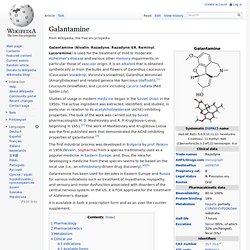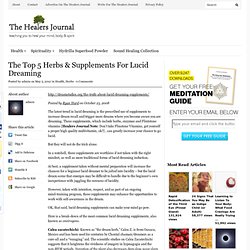

Antropología en línea: Índice. Galantamine. Galantamine (Nivalin, Razadyne, Razadyne ER, Reminyl, Lycoremine) is used for the treatment of mild to moderate Alzheimer's disease and various other memory impairments, in particular those of vascular origin.

It is an alkaloid that is obtained synthetically or from the bulbs and flowers of Galanthus caucasicus (Caucasian snowdrop, Voronov's snowdrop), Galanthus woronowii (Amaryllidaceae) and related genera like Narcissus (daffodil)),[1] Leucojum (snowflake), and Lycoris including Lycoris radiata (Red Spider Lily). Studies of usage in modern medicine began in the Soviet Union in the 1950s. The active ingredient was extracted, identified, and studied, in particular in relation to its acetylcholinesterase (AChE)-inhibiting properties.
The bulk of the work was carried out by Soviet pharmacologists M. D. The first industrial process was developed in Bulgaria by prof. It is available in both a prescription form and as an over the counter supplement. The Top 5 Herbs & Supplements For Lucid Dreaming. Digg Posted by Ryan Hurd on October 23, 2008 The latest trend in lucid dreaming is the prescribed use of supplements to increase dream recall and trigger more dreams where you become aware you are dreaming.

These supplements, which include herbs, enzymes and Flintstone vitamins [Healers Journal Note: Don't take Flinstone Vitamins, get yourself a proper high quality multivitamin, ok?] , can greatly increase your chance to go lucid. But they will not do the trick alone. In a nutshell, these supplements are worthless if not taken with the right mindset, as well as more traditional forms of lucid dreaming induction.
At best, a supplement taken without mental preparation will increase the chances for a beginner lucid dreamer to be jolted into lucidity – but the lucid dream scene that emerges may be difficult to handle due to the beginner’s own inexperience with juggling the rawness of lucidity. OK, that said, lucid dreaming supplements can make your mind go pow. * Lucid Dreams * 60 Capsule Lucid Dreaming Supplement & Lucid Dream Instructional E-Handbook. Huperzine, Choline, 5-HTP, Melatonin and more!: Health & Personal Care.
Salvia divinorum. Salvia divinorum (also known as Diviner's Sage,[2] Ska María Pastora,[3] Seer's Sage,[4] and by its genus name Salvia) is a psychoactive plant which can induce "visions" and other hallucinatory experiences.

Its native habitat is in cloud forest in the isolated Sierra Mazateca of Oaxaca, Mexico, where it grows in shady and moist locations.[5][6] The plant grows to over a meter high,[1] has hollow square stems, large leaves, and occasional white flowers with violet calyxes. Botanists have not determined whether Salvia divinorum is a cultigen or a hybrid; native plants reproduce vegetatively, rarely producing viable seed.[7][8] Mazatec shamans have a long and continuous tradition of religious use of Salvia divinorum, using it to facilitate visionary states of consciousness during spiritual healing sessions.[1] Most of the plant's local common names allude to the Mazatec belief that the plant is an incarnation of the Virgin Mary, with its ritual use also invoking that relationship.
History. Salvia Divinorum Mexico. Salvia divinorum. Artemisia vulgaris. Descripción[editar] Es una planta perennifolia herbácea de 1 a 2 m (raramente 2,5 m), con raíces leñosas.

Las hojas de 5 a 20 cm de longitud, verde muy oscuras, pinnadas, con pelos blancos densos tomentosos en el envés. El tallo erecto tiene un tinte rojo purpúreo. Flores pequeñas (5 mm de long.) son radialmente simétricas con muchos pétalos amarillos o rojo oscuras. Tiene numerosos y angostos capítulos (cabezas florales) se abren en panículas racimosas.
Distribución y hábitat[editar] Es nativa de áreas templadas de Europa, Asia, norte de África, está en Norteamérica donde es una maleza. Usos[editar] Ilustración del s. La artemisa tiene tujona, que es tóxica. Alimento[editar] Hojas y capullos, bien picados antes de la floración de julio, se usaban para un agente saborizador amargo para carne grasa y pescado. Se la usaba en Corea y en el Japón para tortas de arroz festivas, dándoles un color verdoso.